Massoud M. Engineering Thermofluids: Thermodynamics, Fluid Mechanics, and Heat Transfer
Подождите немного. Документ загружается.


622 Va. Two-Phase Flow and Heat Transfer: Two-Phase Flow Fundamentals
Constants C
1
, C
2
, and C
3
may be obtained from the Martinelli-Nelson or the Thom
correlation. Figure Va.2.3 gives the values of constants C
1
, C
2
, and C
3
according
to Thom’s correlation.
Example Va.2.9. Solve Example Va.2.8 based on the Separated Flow Model.
Solution: The same total pressure drop is applicable in the preheating section for
both HEM and SFM. For the boiling section, we use Figure Va.2.3 for (∆P)
fric
,
(∆P)
acc
and (∆P)
grav
respectively. These result in: C
1
≈ 8.5, C
2
≈ 14, and C
3
≈ 0.24.
Substituting the constants in Equation Va.2.30, we find:
)(
2
1
)(
1
2
,
C
LG
D
fP
sp
b
h
sptpfric
ρ
=∆ =
=×
××
5.8
2
00135.03)3.318(
02.0
1
0199.0
2
1.74 kPa
)](/[)(
2
2
,
CGP
ftpacc
ρ
=∆ = (318.3)
2
× 0.00135 × 7.8 = 1.90 kPa
)(cos)(
3,
CgLP
fbtpgrav
βρ
=∆ = 9.81 × (3/0.00135) × 0.24 = 5.2 kPa
Therefore, total pressure drop over the tube is found as:
∆P
total
= (0.068 + 1.74) + (0.018 + 1.90) + (7.8 + 5.2) = 16.7 kPa
This result is in reasonable agreement with the result obtained from the homoge-
nous model in Example Va.2.8.
3. Two Phase Critical Flow
Similar to the critical flow of compressible, single-phase fluid, as discussed in
Chapter IIIc, flow of a two-phase mixture in a channel may also become critical.
For cases where saturated water is contained under pressure, opening of a valve or
sudden burst of a connecting pipe results in expulsion of the tank inventory. In
such a case, the saturated water may partially flash to steam as it approaches the
break area, which is at much lower pressure. We will seek an analytical solution
for the two-phase critical flow of water and steam under the following conditions;
flow is homogeneous (V
f
= V
g
), thermodynamic equilibrium exists between the
phases (T
f
= T
g
), and the process is isentropic. These assumptions lead to the de-
termination of critical flow for HEM. Maintaining the assumption of an isentropic
process, analytical solutions are also extended to two equilibrium non-homo-
genous cases. The first case uses a slip ratio calculated from either the Moody or
the Fauske model. The second case uses models from Burnell and Henry-Fauske.
These cases are summarized in Table Va.3.1 and then discussed in detail next.
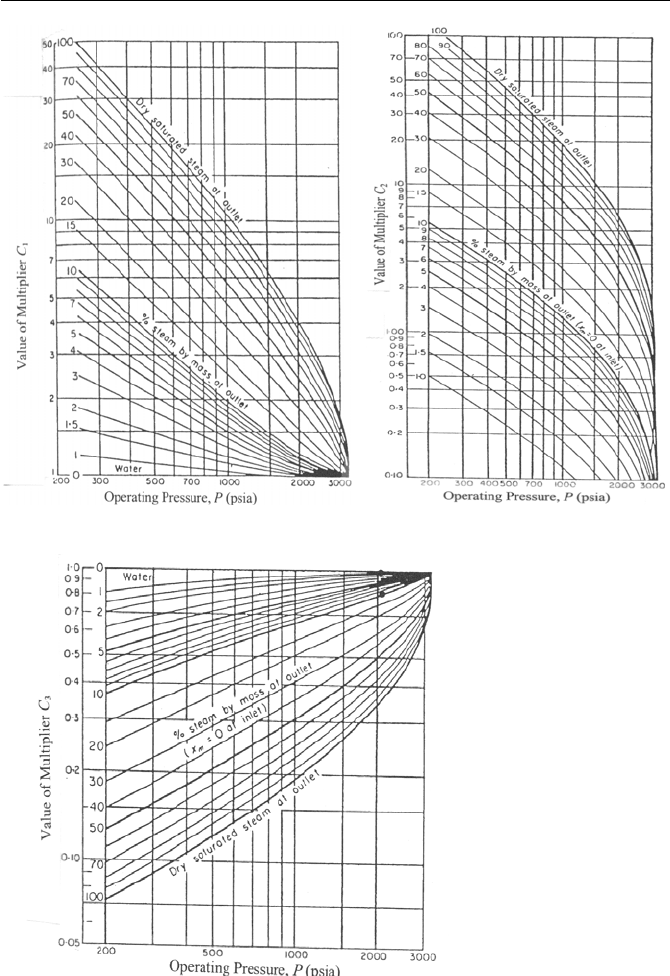
3. Two Phase Critical Flow 623
Figure Va.2.3. Coefficients for frictional, acceleration, and gravitational pressure drop
(Thom 1964)
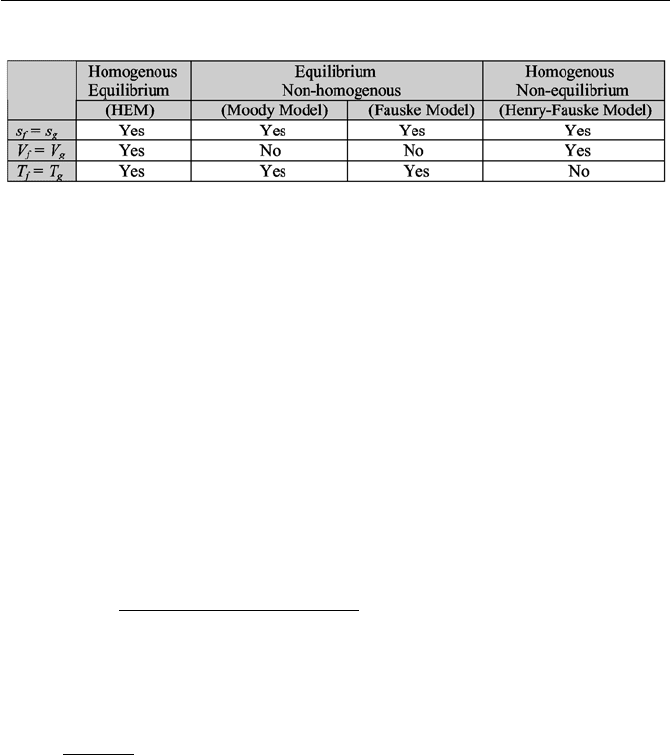
624 Va. Two-Phase Flow and Heat Transfer: Two-Phase Flow Fundamentals
Table Va.3.1. Various critical flow models
3.1. Two-Phase Critical Flow (Homogeneous Equilibrium Flow)
This model is based on solving the conservation equations of mass and energy, in
conjunction with the equations of state, under steady-state condition. The conser-
vation equation of mass becomes:
VAm
ρ
=
= constant IIa.5.2
where
ρ
is the mixture density. Note that no distinction is made between V
f
and
V
g
. The energy equation for the mixture, using the upstream stagnation condition
(shown with subscript o), becomes:
h
o
= h + V
2
/2 IIIc.2.1
We may substitute for velocity from Equation IIIc.2.1 into IIa.5.2 and write the re-
sult in terms of mass flux:
()
[]
gf
gfo
xx
xhhxh
VG
vv)1(
)1(2
2/1
+−
−−−
==
ρ
Va.3.1
where we also made use of the equation of state for h = (1 – x)h
f
+ xh
g
. If we sub-
stitute for quality calculated from the mixture entropy
fg
f
ss
ss
x
−
−
=
o
into Equation Va.3.1, we obtain a relation that is solely a function of pressure. By
iteration with the steam tables, we can then find a pressure that maximizes mass
flux. Alternatively, we may express all thermodynamic properties and their de-
rivatives as functions of pressure (examples of such functions are given in Appen-
dix II, Table A.II.3). To find the pressure that maximizes mass flux, we then sub-
stitute these functions into Equation Va.3.1, take the derivative of G and set it
equal to zero.
3.2. Two-Phase Critical Flow (Equilibrium Non-homogeneous Flow)
This is similar to the homogenous flow, but we must account for V
f
≠ V
g
. The
mass balance becomes:

3. Two Phase Critical Flow 625
f
f
g
g
g
g
g
g
V
x
V
xA
W
xA
xW
A
W
G
v1
1
v/
/
¸
¹
·
¨
©
§
−
−
=
¸
¹
·
¨
©
§
=
¸
¹
·
¨
©
§
===
ααα
α
Va.3.2
The energy equation can be partitioned to account for the contribution of each
phase as follows:
()
¸
¸
¹
·
¨
¨
©
§
++
¸
¸
¹
·
¨
¨
©
§
+−=
22
1
22
o
g
g
f
f
V
hx
V
hxh
Va.3.3
To find G, we first substitute for void fraction from Equation Va.1.3. We then
find V
f
and V
g
in terms of G from Equation Va.3.1, substitute them into Equation
Va.3.2, and solve for G to obtain:
()
»
»
¼
º
«
«
¬
ª
−−−=
fg
fg
fef
s
h
sshhG
o
2*
ρ
Va.3.4
where in Equation Va.3.4,
ρ
* is given by:
[]
»
¼
º
«
¬
ª
+
−
+−= x
S
x
xxS
gf
2
2
1
vv)1(
*
1
ρ
Va.3.5
Note that in Equation Va.3.5 the slip ratio S as given by Equation Va.1.1 should
not be confused with s, the specific entropy. We now need to determine the slip
ratio such that the mass flux is maximized. There are two models for this, as dis-
cussed next.
The Moody Model. In this model, the mass flux given by Equation Va.3.4 is
maximized by setting the derivative of the kinetic energy with respect to slip ratio
equal to zero,
∂K.E./∂S = 0:
()
0
22
1
22
=
»
»
¼
º
«
«
¬
ª
+
−
∂
∂
gf
xVVx
S
Taking the derivative and setting it equal to zero, we obtain:
S
Moody
= (v
g
/v
f
)
1/3
The Moody model compares well with data in the range of 14.7 – 400 psia.
The Fauske Model. In this model, the mass flux given by Equation Va.3.4 is
maximized by setting the derivative of the flow momentum, with respect to slip
ratio, equal to zero:

626 Va. Two-Phase Flow and Heat Transfer: Two-Phase Flow Fundamentals
()
[]
01 =+−
∂
∂
gf
xVVx
S
This maximizes the axial pressure gradient for a given flow rate and steam quality.
Substituting from Equation Va.3.1 for V
f
and V
g
, introducing Equation Va.1.3 for
void fraction, and applying the chain rule for differentiation results in:
S
Fauske
= (v
g
/v
f
)
1/2
Example Va.3.1. Derive the critical condition for annular flow using the conser-
vation equation for mass and momentum.
Solution: We use the thermodynamic equilibrium and non-homogenous assump-
tion, V
f
≠ V
g
. The combined continuity and momentum equations result in.
0)( =++ AdPVmVmd
ggff
Substituting from Equation V.3.2 for V
f
and V
g
in terms of G, we find:
()
0vv
1
1
2
2
2
2
=
»
»
¼
º
«
«
¬
ª
+
−
−
+ G
x
G
x
ddP
gf
αα
Solving for G, we obtain:
()
s
ddPG v/−= Va.3.6
where specific volume in Equation Va.3.6 is given by:
()
gf
xx
vv
1
1
v
2
2
αα
+
−
−
=
Va.3.7
Having found the slip ratio by the Moody or the Fauske method, we express the
thermodynamic properties and their derivatives in terms of pressure and substitute
into Equation IIIa.3.6-2. For example, for the Fauske model, we use Equa-
tions IIIa.3.6-2, Va.1.3 (with
fg
S v/v= ), and Va.3.6 to obtain (Nahavandi):
()
[]
()
()
[]
s
gf
g
dP
dx
xxSSxSSxS
dP
d
xxSx
G
¿
¾
½
¯
®
−+++−−++−=
−
v221v222
v
1
1
22
2
Va.3.8
Nahavandi then plotted Equation Va.3.8 for mass flux as a function of the stagna-
tion enthalpy and pressure, as shown in Figure Va.3.1.
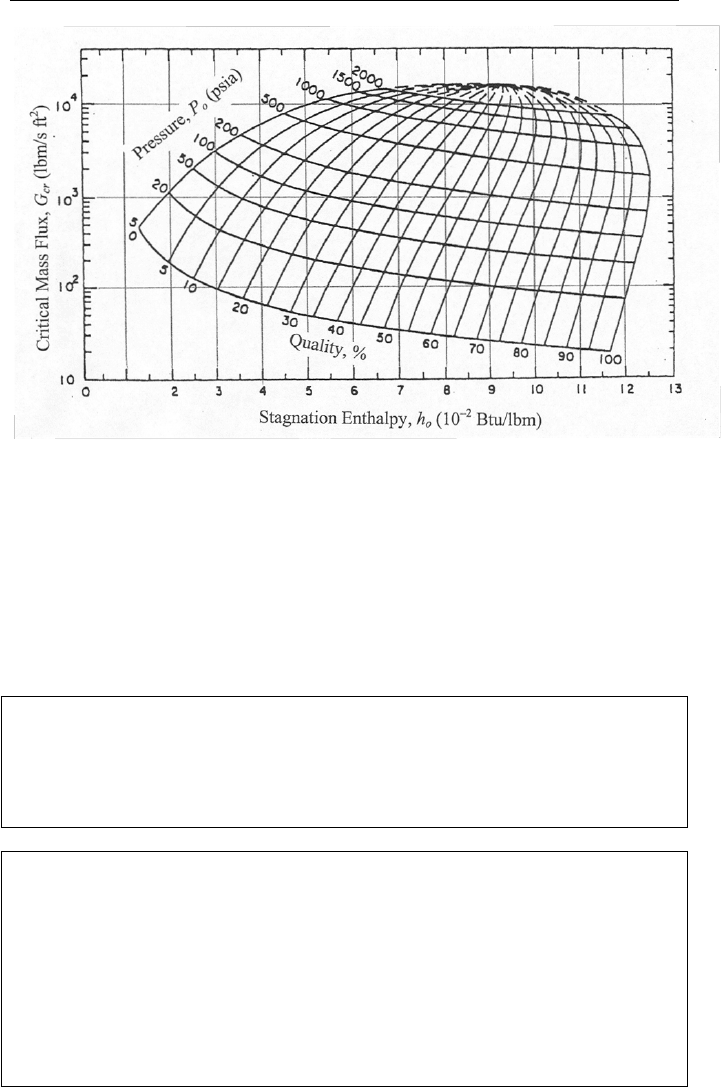
3. Two Phase Critical Flow 627
Figure Va.3.1. Critical mass flux versus stagnation enthalpy and pressure (Fauske)
Two observations can be made from Figure Va.3.1. First, the higher the source
stagnation pressure, the higher the mass flux at the same steam quality. Second,
for a given pressure, the critical mass flux increases with decreasing quality.
Hence, as expected, the higher the liquid content, the higher the critical mass flux.
For example, a stagnation pressure of 200 psia and x = 75% corresponds to the
same mass flux of 1000 lbm/s
⋅ft
2
as a stagnation pressure of only 50 psia but
steam quality of x = 11%.
Example Va.3.2. Calculate the maximum mass flux for the flow of saturated wa-
ter and steam at 2000 psia and enthalpy of 800 Btu/lbm, according to the Fauske
model.
Solution: From Figure Va.3.1 for P
o
= 2000 psia and h
o
= 800 Btu/lbm, we find
G
max
≈ 11,000 lbm/s⋅ft
2
.
Example Va.3.3. A discharge line is connected to a pressurized tank, which con-
tains saturated water at 1000 psia. The discharge line is equipped with a safety
valve, having a flow area of 1.4 in
2
. We now open the valve. Find the maximum
flow rate that leaves the tank. Assume C
d
= 1.
Solution: Since the discharge valve opens to atmosphere, the flow is definitely
choked. The maximum flow rate occurs at the moment that pressure is still at
1000 psia and just begins to drop. Thus from Figure Va.3.1 we find the mass flux
as G
cr
= 10,100 lbm/s⋅ft
2
and the mass flow rate as:
=m
0.8(1.4/144) × 10,100 = 78.5 lbm/s
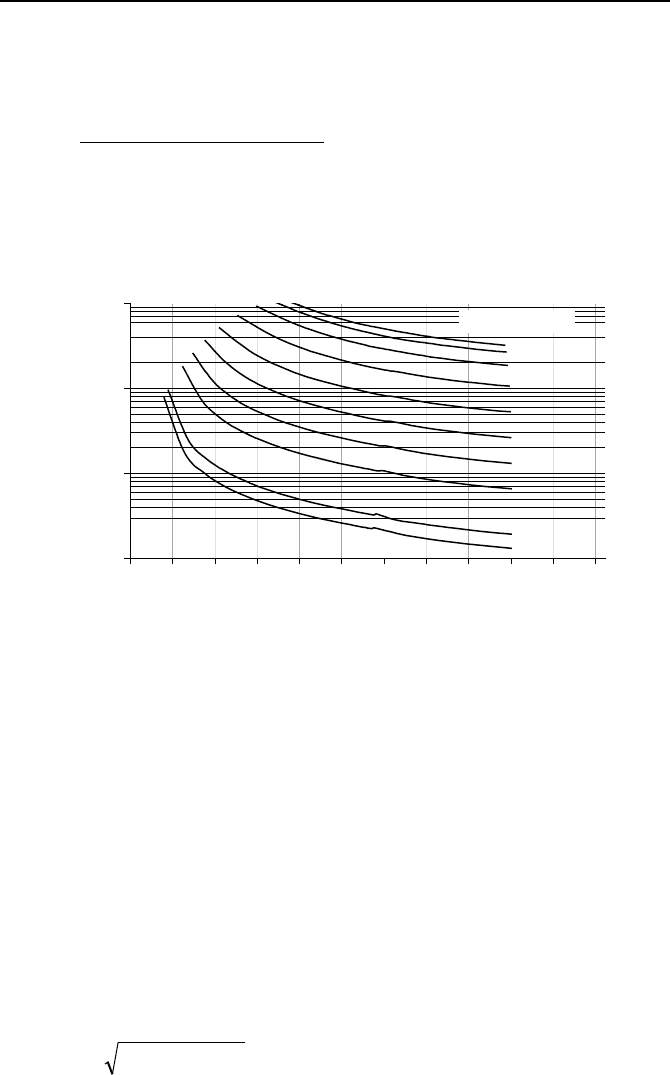
628 Va. Two-Phase Flow and Heat Transfer: Two-Phase Flow Fundamentals
As for the Moody model, if we substitute S = (v
g
/v
f
)
1/3
into Equation Va.3.5 and
then use the result in Equation Va.3.4, we find the following relation for the criti-
cal mass flux:
[
]
[]
3
3/22
g
2
)v/v)(1(v
)1(2
gf
fgo
xx
hxxhh
G
−+
−−−
=
Va.3.9
Similar to the Fauske mode, mass flux from the Moody model is maximized and
plotted for various values of the source stagnation pressure and enthalpy, as shown
in Figure Va.3.2.
1.E+01
1.E+02
1.E+03
1.E+04
0 200 400 600 800 1000 1200 1400 1600 1800 2000 2200
Stagnation Enthalpy, h
o
(Btu/lbm)
Critical Mass Flux, G
cr
(lbm/s ft
2
)
10
14.7
50
400
800
1400
2000
2400
100
200
Pressure,
P
o
(psia)
Figure Va.3.2. Critical mass flux versus stagnation enthalpy and pressure (Moody)
3.3. Two-Phase Critical Flow (Homogeneous Non-equilibrium Flow)
Earlier we showed that the existence of analytical solutions was primarily due to
the isentropic process assumption. This assumption implies that the length and di-
ameter of the flow path should be such that the frictional effects are minimized.
Thermodynamic equilibrium in turn requires a reasonably long flow path to allow
the phases to reach equilibrium. As such, the shorter the flow path, the higher the
flow rate since less liquid would flash to steam. Fauske has identified three ranges
for the L/D; 0–3, 3–12, and 12–40 (Figure Va.3.3). For 0 < L/D < 3, the flow path
is too short for the phases to reach equilibrium while for 12 < L/D < 40, the flow
path allows the phases to reach equilibrium. Therefore, for the L/D range of 0 – 3,
the critical flow can be estimated from such equations as IIIa.3.46, IIIb.3.14,
IIIb.4.3, and IIIb.4.4:
()
crof
PPG −=
ρ
261.0 Va.3.10
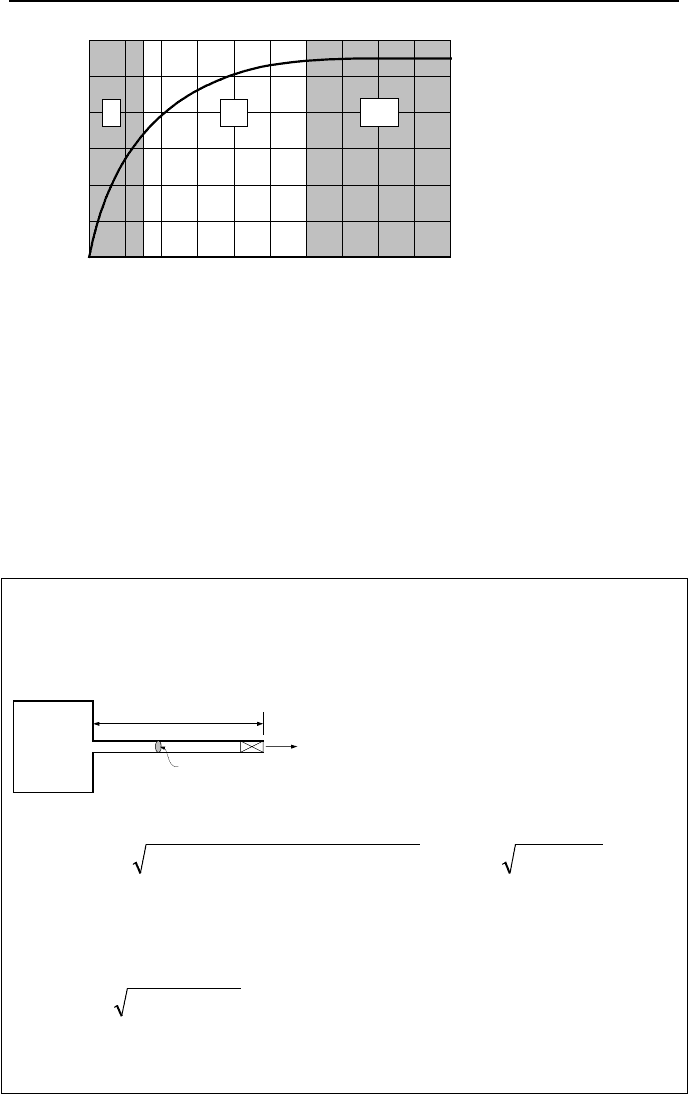
3. Two Phase Critical Flow 629
0.1
0.2
0.3
0.4
0.5
0.6
0.0
02468
10
12 14
16
18 20
I II III
Flow Path L/D
Critical Pressure Ratio,
P
cr
/P
o
Figure Va.3.3. Critical pressure ratio versus flow path length over diameter (Fauske)
where in Equation Va.3.10, a discharge coefficient of 0.61 is accounted for. In
this equation, P
cr
stands for the critical pressure. According to Fauske, the value
of P
cr
depends on the value of the L/D ratio as shown in Figure Va.3.2. Note that,
for an orifice, (L/D = 0), P
cr
is the actual back pressure.
In conclusion, Region I in Figure Va.3.3 is applicable to non-equilibrium flow
regimes and Region III of this figure is well suited for the HEM, since the suffi-
cient flow path length allows the phases to reach thermal equilibrium. Note that
Figure Va.3.1 would under-predict flow in Regions I and II of Figure Va.3.3.
Example Va.3.4. A pressurized tank containing saturated liquid at 2000 psia is
connected to atmosphere by a 0.5 in diameter pipe. A frictionless valve on the
pipe is suddenly opened. Find the maximum mass flux for three different pipe
lengths of L
1
= 0.1 ft, L
2
= 0.25 ft, and L
3
= 1 ft at this pressure.
P
1
L
D
Solution:
Find
() ()
crcr
PPPPG −=−×××=
oo
78.36614498.382.32261.0
Next, we need to find P
o
– P
cr
, having L/D. Since D = 0.5/12 = 0.042 ft
L
1
/D = 0.1/0.042 = 2.4, L
2
/D = 6, and L
3
/D = 24.
We now use Figure Va.3.3:
For L
1
/D = 2.4, we find P
cr
/P
o
= 0.30. Thus,
()
720,13600200078.366 =−=G lbm/s·ft
2
.
This is in good agreement with G from Figure Va.3.1 at
P
o
= 600 psia and h
o
= h
f
(2000) = 672 Btu/lbm.
For L
2
/D = 6.0, we find P
cr
/P
o
= 0.48. Thus,
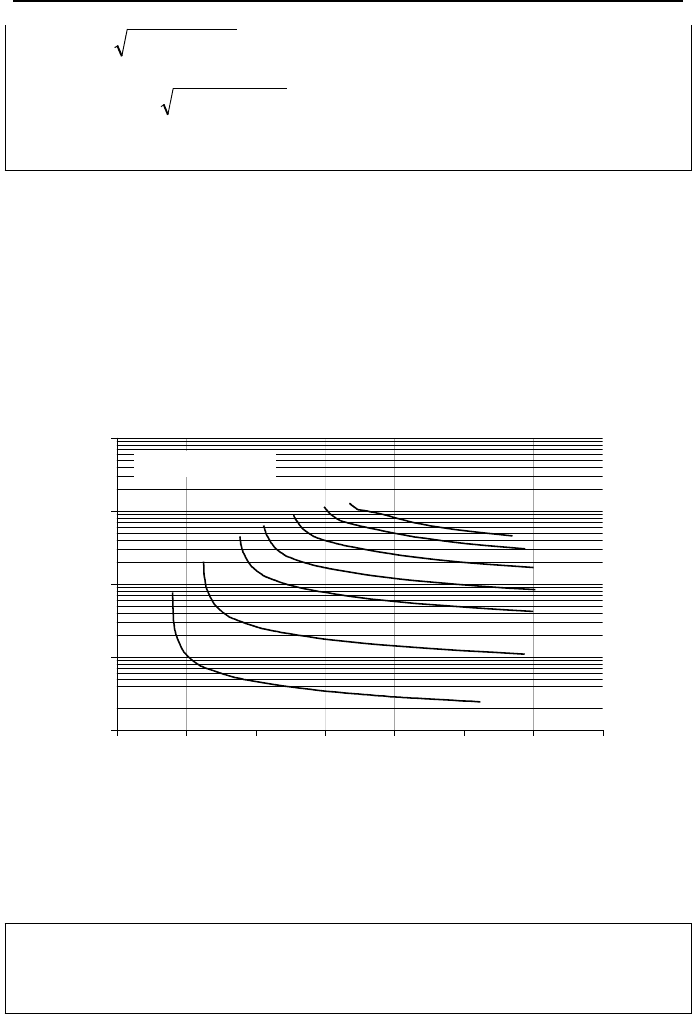
630 Va. Two-Phase Flow and Heat Transfer: Two-Phase Flow Fundamentals
()
830,11960200078.366 =−=G
lbm/s·ft
2
For L
3
/D = 24, we find P
cr
/P
o
= 0.55.
Thus,
()
000,111100200078.366 =−=G
lbm/s·ft
2
As expected, G
cr
is over-predicted compared to G
cr
≈ 8500 lbm/s·ft
2
read from
Figure Va.3.1 at P
o
= 1100 psia and h
o
= h
f
(2000 psia) = 672 Btu/lbm.
Henry (1970) and later Henry-Fauske (1971) analytically derived the relation
for two-phase critical mass flux for homogenous non-equilibrium flow, based on
the isentropic assumption. This is a reasonable assumption for short flow paths
for which the frictional pressure drop due to the wall shear forces is negligible
compared to the momentum and pressure gradient terms. The RELAP4 (Moore)
and GOTHIC (George) computer codes have tabulated the Henry correlation for
various stagnation pressure and enthalpy. These are plotted in Figure Va.3.4.
1.E+01
1.E+02
1.E+03
1.E+04
1.E+05
0 200 400 600 800 1000 1200 1400
Stagnation Enthalpy, h
o
(Btu/lbm)
Critical Mass Flux,
G
cr
(lbm/s ft
2
)
10
50
200
400
800
1400
2000
Pressure, P
o
(psia)
Figure Va.3.4. Critical mass flux versus stagnation enthalpy and pressure (Henry non-
equilibrium model)
Example Va.3.5. In Example Va.3.5, find the maximum mass flux for L
1
= 0.1 ft.
Solution: From Figure Va.3.4 for P
o
= 2000 psia and saturated water, we find
G
max
≈ 10,500 lbm/s ft
2
.
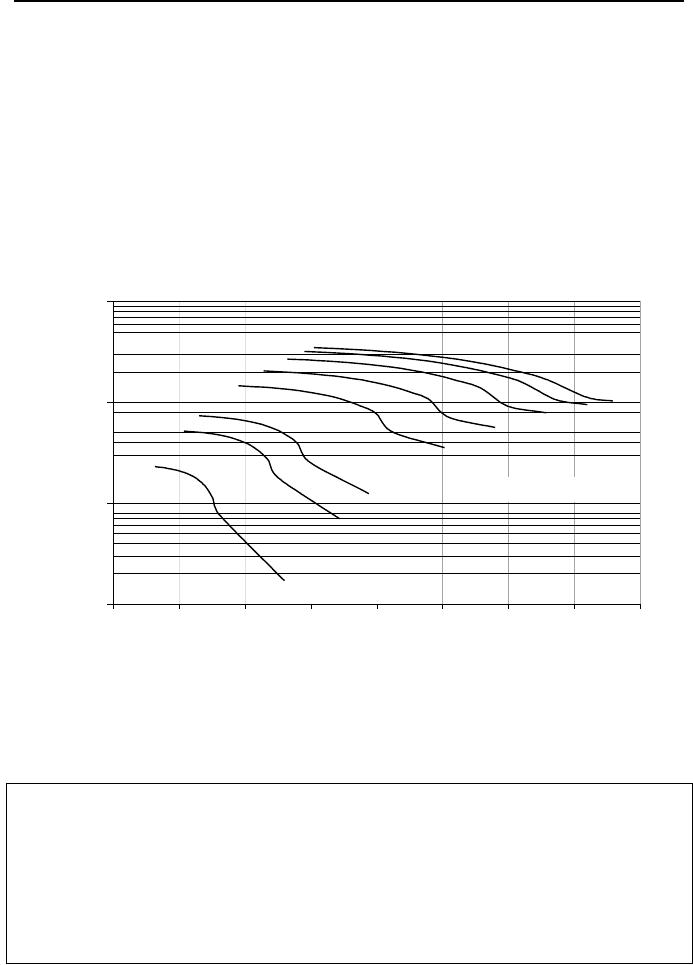
3. Two Phase Critical Flow 631
3.4. Two-Phase Critical Flow
(Homogeneous Non-equilibrium, Subcooled Fluid)
So far we dealt with saturated water and two-phase mixture. If the pressurized
water is subcooled, then the percentage of flashing decreases, resulting in higher
mass flow rate. Indeed test data indicates that the higher the degree of subcooling,
the higher the critical mass flow rate. The Henry-Fauske correlation is extended
to cover subcooled liquid. The extended Henry-Fauske correlation for maximum
mass flux is plotted as a function of stagnation enthalpy and pressure in Fig-
ure Va.3.5.
1.E+02
1.E+03
1.E+04
1.E+05
0 100 200 300 400 500 600 700 800
Stagnation Enthalpy, h
o
(Btu/lbm)
Critical Mass Flux,
G
cr
(lbm/s ft
2
)
10
50
100
400
800
1400
2000
2400
Pressure,
P
o
(psia)
Figure Va.3.5. Critical mass flux versus stagnation enthalpy and pressure (Henry-Fauske
model)
Example Va.3.6. A pressurized tank containing subcooled liquid at 2000 psia is
connected to atmosphere by a frictionless valve. Find the maximum mass flux for
two cases of h
1
= 400 Btu/lbm and h
2
= 600 Btu/lbm.
Solution: We expect to obtain higher mass flux at lower upstream enthalpy. Ac-
cording to Figure Va.3.5, at a upstream pressure of 2000 psia and enthalpy of 400,
the critical mass flux is about 12,000 lbm/s. At the same pressure but enthalpy of
600 Btu/lbm, the critical mass flux is about 10,800 lbm/s.
